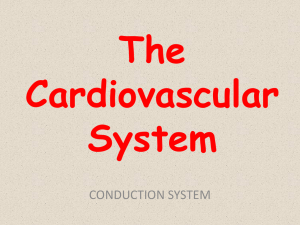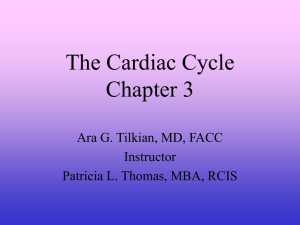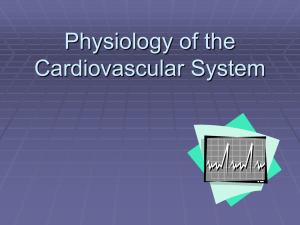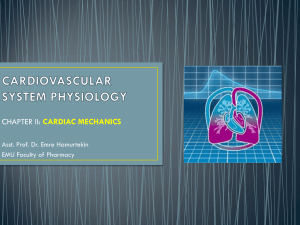Pressure Changes in the Heart
advertisement
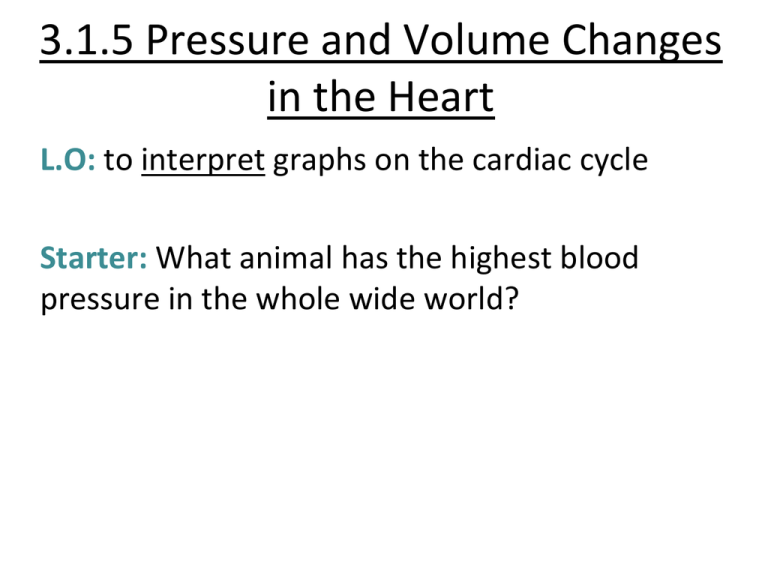
3.1.5 Pressure and Volume Changes in the Heart L.O: to interpret graphs on the cardiac cycle Starter: What animal has the highest blood pressure in the whole wide world? What’s the keyword? Activity 1) Place your whiteboard on the table, use the rulers as axes around the whiteboard 2) Divide the whiteboard into the three stages of the cardiac cycle (start with atrial systole) 3) Use one piece of wool to show the pressure changes in the atria 4) Use a different coloured piece of wool to show the pressure changes in the ventricles Extension: Can you redo step 2 to think about how long each stage roughly lasts for? Pressure Changes in the Heart Atrial Systole Ventricular Systole Diastole Pressure Changes in the Heart Atrial Systole Ventricular Systole Atria pressure increases due to contraction Diastole Pressure Changes in the Heart Atrial Systole Ventricular Systole Atria pressure increases due to contraction Atria pressure decreases as atria relax Diastole Pressure Changes in the Heart Atrial Systole Ventricular Systole Atria pressure increases due to contraction Atria pressure decreases as atria relax Diastole Atria pressure increases as atria fill Atrial Systole Ventricular Systole Diastole Atrial Systole Ventricular pressure increases slightly due to passive filling Ventricular Systole Diastole Atrial Systole Ventricular Systole Ventricular pressure increases due to contraction Ventricular pressure increases slightly due to passive filling Diastole Atrial Systole Ventricular Systole Ventricular pressure increases due to contraction Ventricular pressure increases slightly due to passive filling Diastole Ventricular pressure decreases as ventricles relax Atrial Systole Ventricular Systole Ventricular pressure increases due to contraction Ventricular pressure increases slightly due to passive filling Diastole Ventricular pressure decreases as ventricles relax Ventricular pressure increases slightly due to passive filling Volume Changes 150 Volume of left ventricle 100 (cm3) 0 0 0.1 0.2 0.3 0.4 0.5 Time (secs) Atrial Ventricular Systole Systole Ventricular Diastole 0.6 0.7 0.8 Volume Changes 150 Thinking task! What do you think the line would look like? Volume of left ventricle 100 (cm3) 0 0 0.1 0.2 0.3 0.4 0.5 Time (secs) Atrial Ventricular Systole Systole Ventricular Diastole 0.6 0.7 0.8 Volume Changes 150 Volume of left ventricle 100 (cm3) 0 0 0.1 0.2 0.3 0.4 0.5 Time (secs) Atrial Ventricular Systole Systole Ventricular Diastole 0.6 0.7 0.8 Pressure Changes in the Heart Match the letter on the graph to the following events Semi-lunar valves open Atrio-ventricular valves close, Semi-lunar valves close Atrio-ventricular valves open atrio-ventricular valves close semi-lunar valves open atrio-ventricular valves close semi-lunar valves open semi-lunar valves close atrio-ventricular valves close semi-lunar valves open semi-lunar valves close atrio-ventricular valves close atrio-ventricular valves open I can describe the three main stages of the cardiac cycle No No Yes I can explain the how the heart is controlled by electrical impulses Use the AS revision guide page 40 and 41 to make notes Can you see where you went wrong? Ask me for help Complete sheet B. What was your score? Yes I can interpret pressure and volume graphs on the cardiac cycle Yes No Yes Complete sheet A. Did you score over 85% ?
